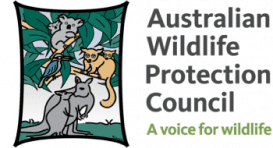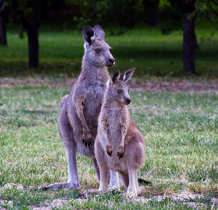
Us And Them — The End Game?
Share this page ABOVE: from a hunting website in Queensland a year ago. As in Queensland, the NSW government is actively calling for ‘volunteers’ to shoot the wildlife – “to help the farmers” they say. Apart from basic ethical and usefulness issues, in both states there is no evidence of oversight on capacity to shoot accurately; take care of joeys; or manage any welfare questions. by Maria Taylor – 27/06/2018 Taken from: https://districtbulletin.com.au/us-end-game/ THE FOLLOWING IS an excerpted chapter from book Injustice, the War on Australian Wildlife by Maria Taylor. The subject is Australia’s fraught relationship with much of its wildlife since colonial times and how certain values and beliefs have stuck with many of us in this country. The kangaroo species that are hunted and unjustly treated as pests is the standout case study. The mainstream version of our relationship to this unique marsupial is told every day as with one voice by graziers and some farmers, major political parties, some applied ecologists, mass media and in most cases, the kangaroo ‘harvesting’ industry. Together they support the world’s biggest terrestrial wildlife slaughter. The countless millions of kangaroos people believe are bounding across the landscape are in large part a mathematical figment that has received well-deserved deconstruction. In this chapter Taylor talks to two former ‘roo shooters who tell a different story – not from a desktop, but from ground-level. They reveal the horrors that are going on right now in south west Queensland in the name of drought relief and to prop up hopes for revival of a sheep industry there. And the same ideas and proposed solution to blame kangaroos are seeping into NSW. “I rang the federal member for Roma the other day and said: have you been into parliament to tell them to change the coat of arms for Australia? She says why? I said because you’ve shot the kangaroo and emu out. She slammed the phone down on me. “Between the drought and the cluster fencing; the poisoning (of waterholes) and the shooting; the kangaroo is wiped out in western Queensland.” — Tom King Snr, Cunnamulla “We’ve been driving through (Central Queensland) for seven years. Except for one very wet year we have seen (and smelt) lots of dead animals. One year we saw the bodies of kangaroos and other wildlife every five metres around Longreach. We’ve seen dingoes killed and scalped and hung from posts and large poison bait (1080) signs. The region has an all-out assault on wildlife. These ways of treating wildlife are very traditional; but what about the desire in these areas to increase tourism?” — Dr Arian Wallach, University of Technology Sydney,conducting dingo research in Central Queensland LYN GYNTHER TELLS me that she lives next door to an abattoir. She recounts a recent experience with a load of cattle. They had been left there by the owner over the weekend with no feed and as much water as a dog would drink in a day. She got on the phone to the owner and told him that if he didn’t come around with some feed and water, she’d do it and bill him. He came. I had gone to Central Queensland to interview Lyn Gynther and Tom King about their first-hand experiences. Lyn, from around Warwick, is a fighter for animals but she was also a killer of animals as a former roo shooter. Tom King from Cunnamulla is also outspoken for wildlife these days while still a licensed and sometimes practicing roo shooter. To be accurate, he’d like to be a roo shooter who can still make some income in an arena the kangaroo industry and state and national governments insist is sustainable wildlife management. Given his unusual outspokenness he’s also been pushed off properties and called crazy; or lying for breaking the tradition that demands conformity and silence towards outsiders – characteristic of many communities, particularly rural communities, in Australia as elsewhere. But with an intractable drought pitting domestic stock graziers against the commercial kangaroo ‘harvesting’ business, let alone wildlife welfare advocates, things have been breaking out into the news. From the kangaroo industry’s perspective the wildlife ‘resource’ is being wiped out. Tom in particular has interested local journalists by fingering as a major culprit the kilometres of cluster fencing nominally aimed at stopping wild dogs that maul sheep. But the fences also cut across remaining wildlife corridors to water and to opportunistic forage. Both Lyn and Tom told me about the destruction being rained down on kangaroos and wallabies and, more quietly, emus, by a state government mitigation program to help the graziers. This entails generous open season permits to shoot macropods for three years being issued for 2017–2020. ‘Mitigation’ has in some places opened the door for recreational shooters being invited onto grazing properties to blast away at any wild-living animal unfortunate enough to be caught up by the fencing maze. This is happening on Mitchell Grass plains interspersed with mulga and Gidgee native tree belts where there has been conversion since the mid-1990s from sheep to frequently opportunistic cattle grazing – a situation that local and state politicians in 2018 herald as starting to reverse itself thanks to the fencing. They have hailed the move back to sheep as the newest saviour for outback communities like Cunnamulla. Back to tradition is a time-honoured Australian response to a challenging environment. Drought and now climate change WHAT SHOULD BE predictable drought, (it’s happened since colonial days), has been intensified and made less predictable by present-day climate change. Six-, seven-year or longer drought now frames a renewed war on wildlife as paddocks lie bare of forage. It reads like a 21st century replay of the colonial annihilation of the native inhabitants from ‘private property’ that new settlers claimed across the landscape. Talking to the current settlers, long-standing myths, demonization, and false facts soon emerge regarding remaining kangaroo mobs, complicated again by the activities of the commercial harvesters. For example, recent policies to target only male animals (to get around the bad public relations


